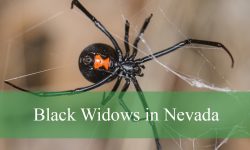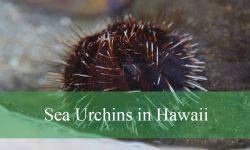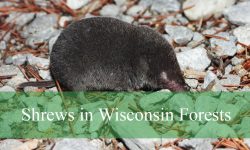Michigan is home to a rich diversity of frog species, each with unique colors, calls, and habitats. From the tiny Spring Peeper to the large American Bullfrog, these amphibians play a vital role in local ecosystems.
Frogs in Michigan can be found in forests, wetlands, ponds, and streams. Their presence indicates healthy habitats, and spotting them can be a rewarding experience for nature enthusiasts.
This guide covers all 11 native Michigan frog species, providing detailed descriptions, identification tips, and insights into their behavior, diet, and breeding habits.
Common Frogs Found in Michigan
American Bullfrog (Lithobates catesbeianus)
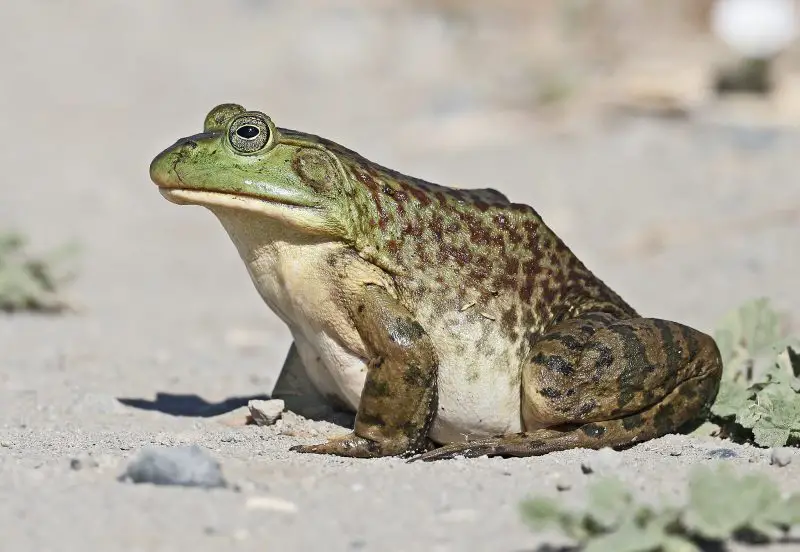
The American Bullfrog is Michigan’s largest native frog, easily recognizable by its robust body and large head. Adults typically reach lengths of 3.6 to 6 inches (9–15 cm), with females generally larger than males. Their coloration varies from green to olive brown, with a lighter underside, and they often display irregular dark blotches on their back. A key identifying feature is the prominent tympanum located just behind the eye, which is larger in males.
Bullfrogs are highly aquatic and prefer permanent bodies of water such as ponds, lakes, and slow-moving streams. They are strong swimmers and are rarely found far from water, often hiding among vegetation along the shoreline. In Michigan, they are widespread throughout the southern Lower Peninsula and parts of the Upper Peninsula where suitable habitats exist.
These frogs are voracious predators, feeding on insects, small fish, amphibians, and even small birds or mammals when opportunities arise. They hunt mainly at night, using ambush tactics to capture prey with their sticky tongue. Their powerful legs allow them to leap long distances both in water and on land.
Reproduction occurs in late spring to early summer. Males gather at breeding sites and produce deep, resonant calls to attract females. Females lay thousands of eggs in floating masses in shallow water. Tadpoles may take one to two years to metamorphose into juvenile frogs, depending on water temperature and food availability.
Green Frog (Lithobates clamitans)
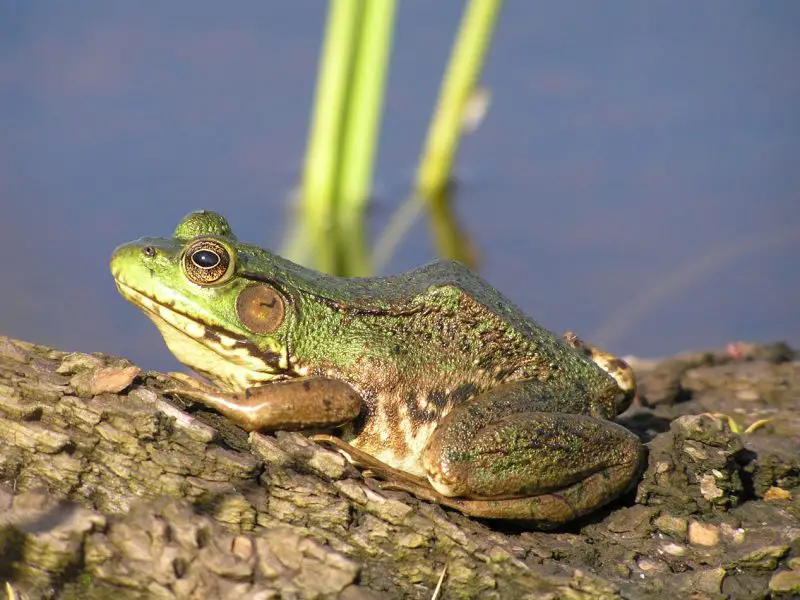
The Green Frog is a medium-sized frog commonly found in Michigan, with adults typically ranging from 2.5 to 4 inches (6–10 cm) in length. Their coloration is generally green to brownish-green with darker mottling on the back. One distinctive feature is the prominent dorsolateral ridges running from behind the eyes down the back, which help differentiate them from similar species like the bullfrog.
Green Frogs prefer ponds, marshes, and slow-moving streams with abundant vegetation. They are semi-aquatic and can often be seen sitting on logs or rocks near water, ready to leap into safety at the first sign of danger. In Michigan, they are widespread, particularly in southern and central regions where wetlands are common.
These frogs feed on a variety of insects, spiders, and small invertebrates. They are primarily active during the day and evening, using a combination of ambush and opportunistic feeding strategies. Their strong hind legs make them excellent jumpers, which they use to escape predators or catch prey.
Breeding occurs from late spring into early summer. Males call with a distinctive “gunk” or “plunk” sound from shallow water to attract females. Eggs are laid in clusters attached to submerged vegetation. Tadpoles develop over the summer and usually metamorphose by late summer or early fall.
Northern Leopard Frog (Lithobates pipiens)
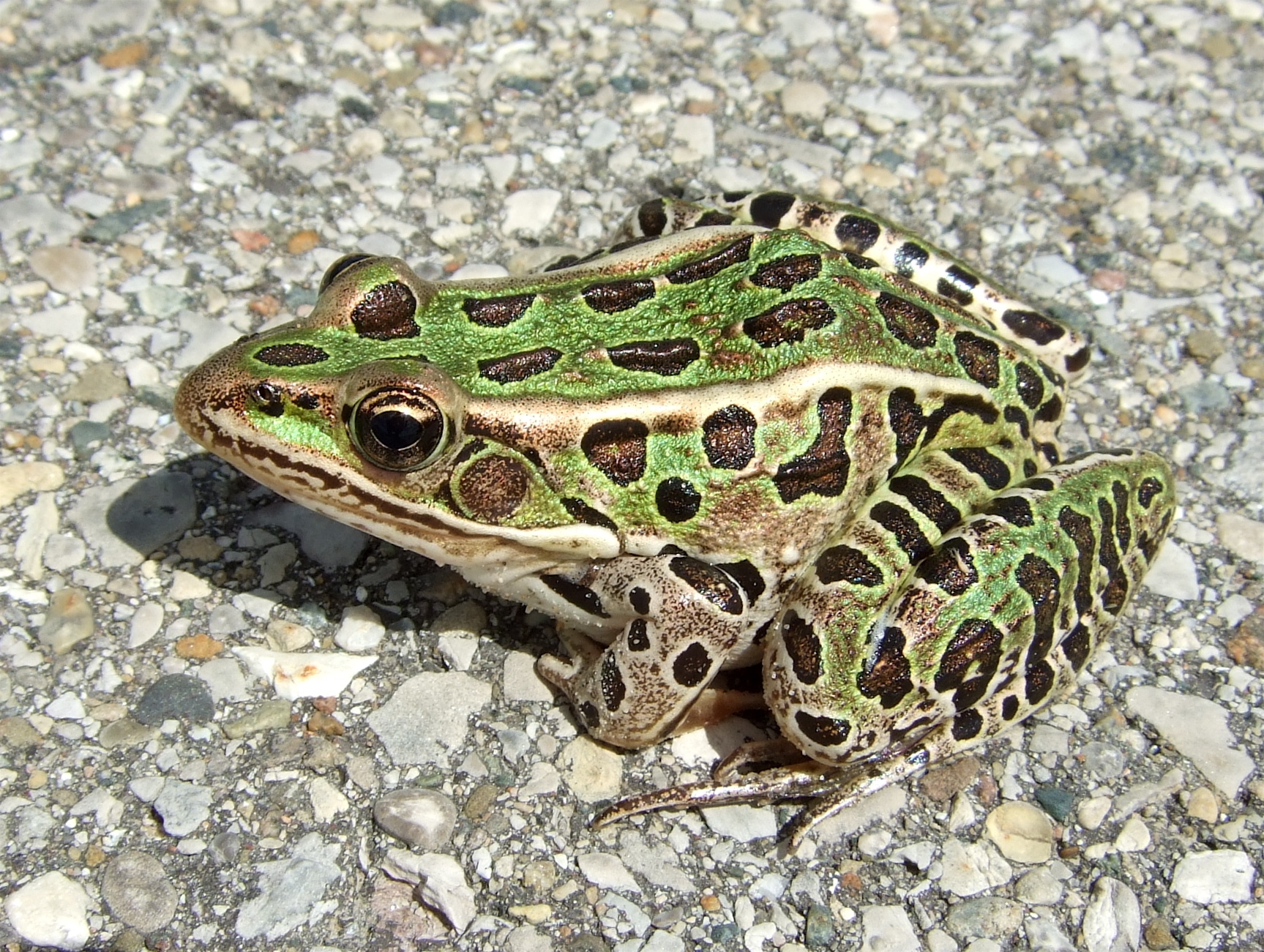
The Northern Leopard Frog is easily identified by its bright green or brown coloration with large, dark, round spots covering its back and legs. Adults typically measure 2 to 4 inches (5–10 cm) long, with females slightly larger than males. They have a slender body and long legs adapted for jumping, and a light-colored stripe running down each side of the back is often visible.
Northern Leopard Frogs favor wetlands, meadows, and grassy areas near permanent or temporary water bodies. They are highly adaptable but require water for breeding and tadpole development. In Michigan, these frogs are most common in the southern and central regions, although populations can be sparse in heavily developed areas.
They are active hunters, feeding on insects, snails, and small invertebrates. Northern Leopard Frogs are both diurnal and nocturnal, often moving through grass and vegetation in search of prey. Their jumping ability allows them to quickly evade predators such as birds, snakes, and mammals.
Reproduction occurs in spring when ice melts and water temperatures rise. Males call from shallow water with a distinctive “snore-like” or low-pitched trill to attract females. Eggs are deposited in clusters and hatch within one to three weeks. Tadpoles transform into frogs over several months, usually by midsummer.
Wood Frog (Lithobates sylvaticus)
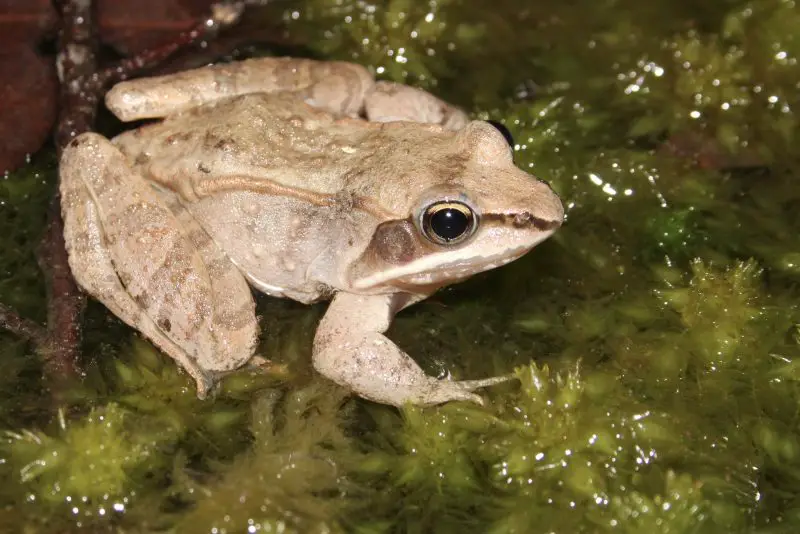
The Wood Frog is a medium-sized frog measuring 1.5 to 3 inches (4–8 cm) in length. It is notable for its brown, tan, or reddish coloration and a dark, mask-like marking that stretches from the nose through the eyes. This facial mask, along with its relatively smooth skin, makes it easy to identify among Michigan’s frog species.
Wood Frogs are highly terrestrial compared to other Michigan frogs. They inhabit forests, wetlands, and woodland edges, often hiding under leaf litter or logs. They are famous for surviving freezing winters by entering a state of freeze tolerance, allowing them to inhabit northern regions where other frogs cannot survive. In Michigan, they are widely distributed across the state, especially in forested areas and near vernal pools.
These frogs feed mainly on insects and spiders, using a sit-and-wait strategy to ambush prey. They are most active during the spring and summer months, with activity declining in the fall as they prepare for hibernation. Their camouflage and quick reflexes help protect them from predators such as snakes and birds.
Breeding is synchronized with early spring thaw. Males congregate in temporary pools or ponds, producing quacking calls to attract females. Females lay clusters of eggs in shallow water. Tadpoles develop rapidly, often completing metamorphosis within six to eight weeks to take advantage of temporary pools before they dry out.
Mink Frog (Lithobates septentrionalis)
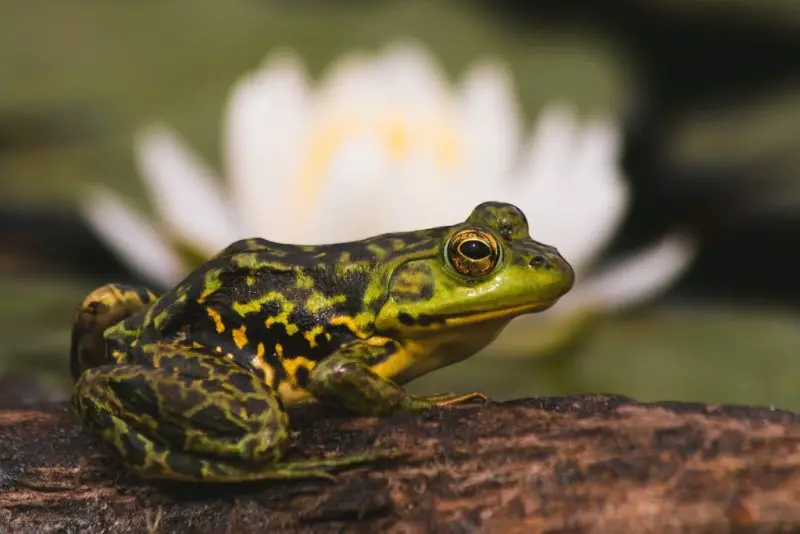
The Mink Frog is a medium-sized aquatic frog, typically 1.5 to 2.5 inches (4–6 cm) long. Its back is green or brown with darker spots, and it has a smooth, glossy skin that emits a strong, musky odor when handled. This distinctive scent, combined with its habitat preferences, makes it relatively easy to identify in Michigan.
Mink Frogs are highly aquatic and prefer cool, permanent ponds, bogs, and marshes with dense vegetation. They are less likely to be found far from water and are excellent swimmers. In Michigan, they are more common in the northern Lower Peninsula and Upper Peninsula, where cooler, wetter environments are prevalent.
They feed primarily on aquatic invertebrates such as insects, snails, and small crustaceans. Mink Frogs are generally more secretive than other frogs, often hiding beneath vegetation or under water to avoid predators. Their legs are strong but shorter than those of more terrestrial frogs, reflecting their aquatic lifestyle.
Breeding occurs in late spring to early summer. Males call with a high-pitched, short trill from shallow water to attract females. Eggs are laid in small clusters attached to submerged vegetation. Tadpoles grow slowly in the cold water and may overwinter before completing metamorphosis the following year.
Pickerel Frog (Lithobates palustris)
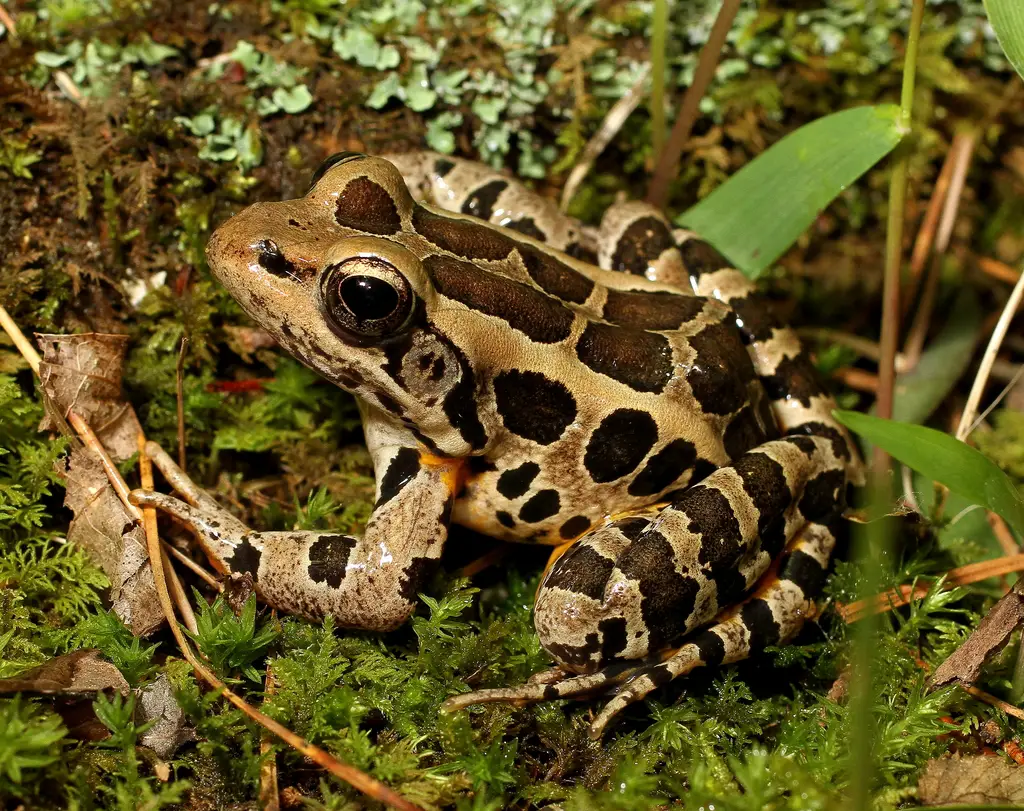
The Pickerel Frog is a medium-sized frog measuring 2 to 3 inches (5–7.5 cm) in length. Its dorsal surface is light brown or tan with distinctive rectangular dark spots arranged in two parallel rows down the back. The ventral side is usually creamy white, and the inner thighs often display bright yellow or orange coloration, which can serve as a warning to predators.
Pickerel Frogs inhabit cool, shallow streams, marshes, and ponds with abundant vegetation. They prefer clear, slow-moving water and are often found near forested wetlands in Michigan. They are more terrestrial than some aquatic species but remain close to water for feeding and breeding purposes.
These frogs are active hunters, feeding mainly on insects, spiders, and other small invertebrates. They are primarily nocturnal and rely on their camouflage to avoid predators. When threatened, the bright coloration on their inner thighs can startle predators and provide a chance to escape.
Breeding occurs in spring, usually from late April to June. Males call from shallow water with a low-pitched, snore-like croak to attract females. Eggs are laid in clusters attached to submerged vegetation. Tadpoles develop over several weeks and metamorphose by mid to late summer.
Spring Peeper (Pseudacris crucifer)
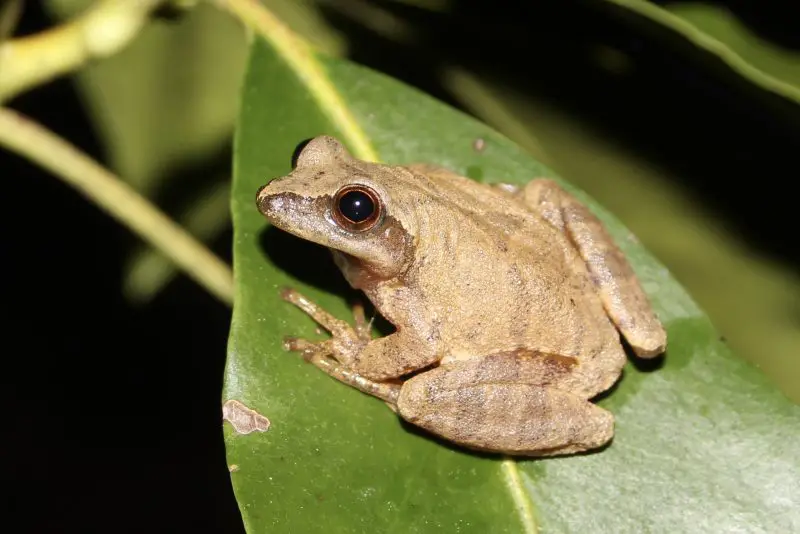
The Spring Peeper is a small frog, measuring only 0.75 to 1.25 inches (2–3 cm) long. Its coloration ranges from tan to brown, and a distinctive dark X-shaped mark on its back makes it easy to identify. Its slender body and long legs make it a skilled jumper despite its small size.
Spring Peepers are primarily found in shallow wetlands, woodland ponds, and marshy areas. They often hide in leaf litter or low vegetation during the day and become more active at night. In Michigan, they are widespread and one of the earliest frogs to call in spring, often when snow is still melting.
These frogs feed on small insects and arthropods. They are highly nocturnal, hunting mainly at night, and rely on stealth and quick jumps to capture prey. Their tiny size and excellent camouflage help them avoid predators such as birds and snakes.
Breeding occurs very early in spring, often in March or April. Males congregate in shallow ponds and produce a high-pitched, whistling call that can be heard for long distances. Females lay eggs individually or in small clusters attached to submerged vegetation. Tadpoles metamorphose over the spring and summer months.
Western Chorus Frog (Pseudacris triseriata)

The Western Chorus Frog is a small species, typically 0.75 to 1.5 inches (2–4 cm) long. Its back is brown or gray with three distinct dark stripes running lengthwise from head to rear, which helps distinguish it from other small frogs. Its belly is pale, and it has smooth skin.
Western Chorus Frogs are commonly found in shallow marshes, ponds, and wet meadows. They prefer temporary pools for breeding and can tolerate drier upland areas during non-breeding periods. In Michigan, they are most abundant in the southern Lower Peninsula.
These frogs feed on small insects and other invertebrates. They are mainly nocturnal and use quick leaps to ambush prey. Their small size and striped pattern make them difficult for predators to spot, increasing their survival rate.
Breeding begins in early spring, often before permanent water bodies are fully thawed. Males produce a trilling call from shallow water to attract females. Eggs are laid in clusters attached to vegetation, and tadpoles develop quickly, often completing metamorphosis within two months to take advantage of temporary water sources.
Gray Treefrog (Dryophytes versicolor)

The Gray Treefrog is a small to medium-sized frog, measuring 1.25 to 2 inches (3–5 cm) in length. Its coloration varies from gray to green, with a mottled pattern that allows it to blend seamlessly with tree bark or leaves. Its sticky toe pads enable it to climb vertical surfaces and vegetation.
Gray Treefrogs are primarily arboreal and inhabit forests, woodlands, and wetlands. They are commonly found in trees, shrubs, or even buildings near water. In Michigan, they are distributed throughout the southern and central regions, favoring areas with abundant vegetation.
These frogs feed on insects and spiders, using their sticky tongue to capture prey. They are mostly nocturnal and rely on camouflage to avoid predators. Their climbing ability allows them to escape ground-dwelling threats effectively.
Breeding occurs from late spring to early summer. Males call from elevated perches with a melodic, trilling sound to attract females. Eggs are deposited in shallow water, often in temporary pools. Tadpoles develop over the summer and metamorphose by late summer or early fall.
Cope’s Gray Treefrog (Dryophytes chrysoscelis)
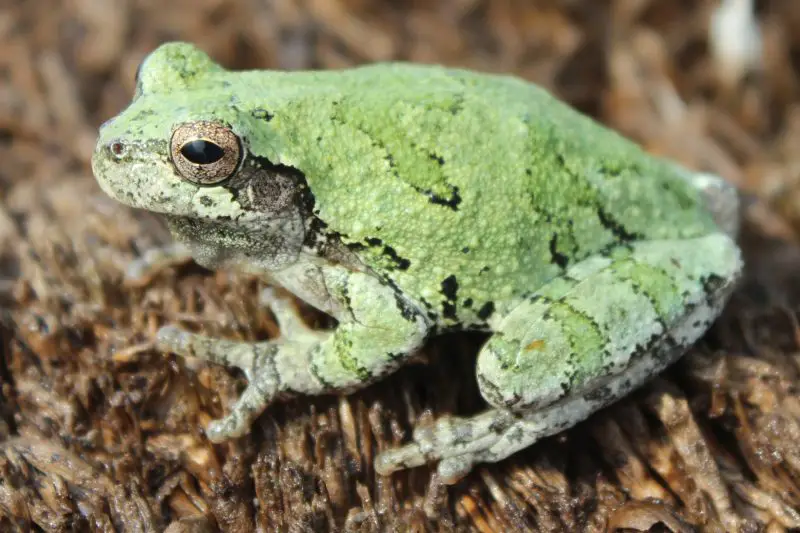
Cope’s Gray Treefrog is very similar in appearance to the Gray Treefrog, ranging from 1.25 to 2 inches (3–5 cm) long. Its coloration is gray or green with irregular dark blotches, and it has sticky toe pads for climbing. The two species are nearly identical visually but differ in their mating calls.
Cope’s Gray Treefrogs inhabit forests, swamps, and wetlands, often taking shelter in trees, shrubs, or man-made structures near water. In Michigan, they overlap in range with Gray Treefrogs, mainly in southern and central regions where suitable habitats exist.
They feed primarily on insects, spiders, and other small invertebrates. Nocturnal by nature, they use stealth and agility to capture prey. Their ability to climb vertical surfaces helps them avoid terrestrial predators.
Breeding occurs in late spring to early summer. Males call from elevated perches with a faster, higher-pitched trill than the Gray Treefrog to attract females. Eggs are laid in shallow water in temporary or permanent pools. Tadpoles develop over the summer and metamorphose by late summer or early fall.
Blanchard’s Cricket Frog (Acris blanchardi)

Blanchard’s Cricket Frog is a small frog, measuring 0.75 to 1.25 inches (2–3 cm) in length. Its back is brown or gray with darker spots and a characteristic triangle or “V” marking between the eyes. Its slender body and long legs allow for quick, bounding movements.
These frogs are commonly found near shallow, vegetated ponds, streams, and wetlands. They prefer sunny, open areas and are highly terrestrial, often moving along the shoreline or through low vegetation. In Michigan, they are primarily found in the southern Lower Peninsula.
Blanchard’s Cricket Frogs feed on small insects and arthropods. They are active during the day and night, often using rapid leaps to capture prey or escape predators. Their small size and camouflage make them difficult for predators to detect.
Breeding occurs from late spring through summer. Males call with a rapid, cricket-like trill to attract females. Eggs are laid in small clusters attached to aquatic vegetation. Tadpoles develop quickly, often metamorphosing within a few weeks during warm summer conditions.
FAQs About Frogs in Michigan
What types of frogs are found in Michigan?
Michigan is home to 11 native frog species. These include the American Bullfrog, Green Frog, Northern Leopard Frog, Wood Frog, Mink Frog, Pickerel Frog, Spring Peeper, Western Chorus Frog, Gray Treefrog, Cope’s Gray Treefrog, and Blanchard’s Cricket Frog. Each species has unique physical features, calls, and habitat preferences.
When is the best time to hear frogs in Michigan?
The peak calling season for most Michigan frogs is spring and early summer, from March through June. Species like the Spring Peeper and Wood Frog are among the first to call in early spring, sometimes when ice is still melting. Other species, such as Bullfrogs and Green Frogs, call later into late spring and early summer.
Where can I find frogs in Michigan?
Frogs are typically found near water bodies, wetlands, marshes, ponds, streams, and vernal pools. Terrestrial species like Wood Frogs and Blanchard’s Cricket Frogs may be found in forests, meadows, and along vegetated edges. Arboreal species like Gray Treefrogs and Cope’s Gray Treefrogs prefer wooded areas with plenty of trees or shrubs.
What do Michigan frogs eat?
Most Michigan frogs are insectivores, feeding on insects, spiders, and other small invertebrates. Larger species, such as the American Bullfrog, may also eat small fish, amphibians, and occasionally small birds or mammals. Frogs hunt primarily at night, using stealth, ambush, or rapid jumping to capture prey.
How do Michigan frogs reproduce?
Michigan frogs breed in spring and early summer. Males attract females with species-specific calls, often from shallow water or elevated perches. Females lay eggs in clusters or masses attached to vegetation. Tadpole development varies by species and temperature, ranging from a few weeks in small ponds to over a year in cooler, permanent water bodies.
Are Michigan frogs endangered or at risk?
Most Michigan frogs are not currently endangered, but habitat loss, pollution, and invasive species can threaten local populations. Wetland protection and maintaining clean water sources are critical for supporting healthy frog populations in the state.


